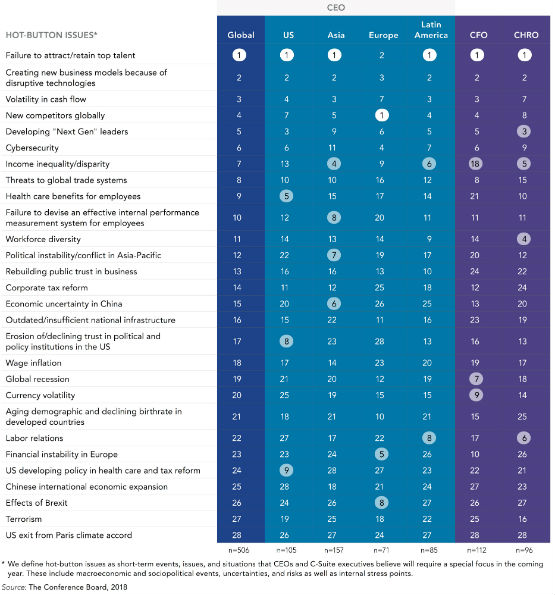C-Suite Challenge 2018 Survey – Labor Markets Implications
31 Jan. 2018 | Comments (0)
Since 1999, The Conference Board CEO Challenge® survey has asked CEOs across the globe to identify their key business challenges and the strategies they intend to use. Over the years, the CEO Challenge has become one of The Conference Board flagship reports, which provides a broad view of business concerns and informs us of member interests and priorities. This week we released the results of the 2018 survey. A full analysis of the results is available here for members of The Conference Board.
In this blog we highlight from the report the key insights related to labor markets. This year, to provide a more holistic view of the global business environment, The Conference Board introduces the C-Suite Challenge™. The new sample includes representation from 21 C-Suite executive functions, including Chief Financial Officers, Chief Human Resources Officers, Chief Information Officers, and Chief Marketing Officers.
To assess their main challenges and pressure points, we presented our respondents with a list of 28 “hot-button issues” that include macroeconomic concerns, geopolitical uncertainty, internal fiscal and human capital issues, and social and environmental pressures (see table below). We also asked them questions about the more specific challenges they face and their strategies for addressing these challenges.
Below are the main findings related to labor markets:
- Because of the improvement in the global economy in 2017 and the strong momentum into 2018, fears of global recession have receded in the minds of CEOs across the globe. Last year it was the top hot-button issue, and this year it dropped to nineteenth.
- The stronger business confidence appears to be shifting the focus of CEOs away from “defensive” (reactive) strategies and more towards “growth” (proactive) strategies. This shows in the new ranking of strategies to achieve “Operational Excellence,” where a "focus on reduction of baseline costs" (which includes many of the labor costs) fell from number one in 2017 to number 13 this year, while improving organizational agility and flexibility became the new number one.
- Failure to attract and retain talent reemerged as the CEOs’ most critical concern. After ranking fourth globally in 2017, talent recruitment and retention is now the top hot-button issue in every global region except Europe, where it is second.
- Despite the tightening labor markets, wage growth remains low compared with the pre-financial crisis period. As a result, concerns over wage inflation as a business challenge, remains a lower priority and is buried in the list for key C-Suite executives. Reflecting the variation in labor market conditions across the globe, concerns about wage inflation are higher in the US, and especially in Asia, than in Europe and Latin America.
- Our C-Suite Challenge survey suggests that increasing the usage of nontraditional workers is likely to become an important strategy for dealing with tightening labor markets. Almost 80 percent of CHROs see a greater use of contingent nontraditional employees as one solution to future worker and skill shortages. In the US, we have seen evidence of an expansion of the share of alternative work arrangements in total employment. Examples of such workers include independent contractors, temporary-help workers, and workers on premise who are hired by outsourcing companies.
- However, we suspect that many of these contingent workers did not join this club by choice, but because of difficulties in landing a regular full-time job, especially in the years following the financial crisis. As labor markets tighten, employers may try to expand the usage of nontraditional workers, but they may find that the supply of such workers has diminished. This is anticipated by our C-Suite respondents — both CEOs and C-Suite executives foresee they will face major problems in finding enough workers with the appropriate high demand skills within the contingent, nontraditional workforce pool.
C-Suite Challenge 2018 Hot-Button Issues: As concerns about global recession fade, issues around talent shortages and the disruption caused by new technologies move to the fore.

-
About the Author:Gad Levanon, PhD
The following is a biography of former employee/consultant Gad Levanon is the former Vice President, Labor Markets, and founder of the Labor Market Institute. He led the Help Wanted OnLine©…


0 Comment Comment Policy